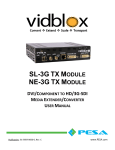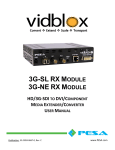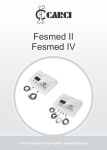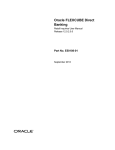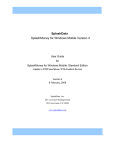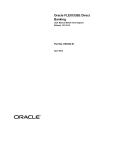Download Visio-Vidblox 3G-SL RX_Quick Start Guide_Rev A_pg1_New
Transcript
Quick-Start Guide 3G-SL RX MODULE Step 1 UNPACK 3G-SL RX MODULE Carefully unpack VidBlox module from shipping container and verify package contents against contents listed below Visually inspect for any signs of damage in shipment or transit If any components are missing or damaged, contact PESA Customer Service PACKAGE CONTENTS: Step 2 GET A CQUAINTED (CONT.) Analog stereo audio output de-embedded from channels 1 & 2 of digital audio group 1 on SDI input signal Active input signal selectable from one of 4 separate SDI input ports - two BNC connectors, and two fiber channels Modules are Ethernet-ready allowing monitoring and configuration functions over a network with PESA’s Cattrax control application, or any single module can be connected to the host PC via a USB connection using Cattrax Cub controller application COMP VGA 1 AC POWER ADAPTER – IF PURCHASED AS STAND-ALONE MODULE USB Cable CA TTRAX CUB INSTALL CD TECH M ANUAL CD 2 VERIFY ITEMS SHOWN ABOVE ARE INCLUDED WITH MODULE* Step 2 GET ACQUAINTED 3G-SL RX Receiver module accepts input of SMPTE compliant HD or 3G-SDI broadcast quality video at resolutions of 720p, 1080i, or 1080p Produces output of DVI or analog video in a user-selectable SDI broadcast or computer graphics format from a set of standard resolutions up to 1920X1200, or one of three custom configurable non-standard output resolutions I/O connections to 3G-SL RX are shown pictorially below RX IN PWR LOCK SYS Video Input Signal System Status LEDs Error LED UNPACK SHIPPING C ONTAINER Quick Start Guide DVI 1 2 IN 1 IN 2 ETHERNET AUDIO OUT VIDEO OUTPUT DL 3G HD LOCK USB SMPTE Video Signal Status LEDs POWER Power On LED Video Output Signal Status LEDs - Indicate format of DVI-D or analog video signal leaving DVI-I connector to video destination as follows: - Composite (COMP) – Composite analog video - VGA – VGA (RGBHV) analog video - DVI – DVI digital video - LOCK – Currently not used with Vidblox RX module System Error LED - Lights when fault or alarm condition is detected within Vidblox module. SMPTE Video Signal Status LEDs - Indicate format and lock status of HD or 3G-SDI digital video signal entering module through selected BNC or fiber connectors as follows: - DL – Currently not used with Vidblox RX module - 3G – Digital video signal is SMPTE compliant 3G-SDI (1080p) - HD – Digital video signal is SMPTE compliant HD-SDI (720p or 1080i) - LOCK – RX module has detected and locked to format of input signal Input Formats: - 720p/50 - 720p/59.94 - 720p/60 - 1080p/50 - 1080p/59.94 - 1080p/60 - 1080i/50 - 1080i/59.94 - 1080i/60 Digital Television Input When modules are mounted in extender frame, power is derived from external power supply(s) and connected to individual modules using connector cables from power distribution module 3G-SL RX modules need not be continuously connected to host PC through a network or USB connection for operation For further information, refer to Chapter 3 in the Vidblox 3G-SL RX User Manual Step 4 CONNECT I/O SIGNALS TO VIDBLOX Receiver module accepts input of HD-SDI (720p or 1080i) or 3G-SDI (1080p) video from any SMPTE compliant source 3G-SL RX Receiver module allows selection of one of four SDI inputs through BNC connectors and fiber channels Active input is automatically detected or may be manually selected through Cattrax or Cattrax Cub Computer graphics video output in user-selectable DVI-D or analog format, and at userselectable resolution up to 1920X1200, or one of three custom-configurable non-standard resolutions available at chassis mounted DVI-I connector Unbalanced output of dual channel analog audio de-embedded from audio channels 1 and 2 of audio group 1 available through 3.5mm stereo connector I/O connections for 3G-SL RX module are shown in following illustration and briefly introduced in following paragraphs Using illustration for reference, complete I/O connections to module prior to applying power SDI Coaxial Input Power On LED - Lights whenever power is applied to Vidblox module For further information, refer to Chapter 3 in the Vidblox 3G-SL RX User Manual Step 3 PLACE STAND-A LONE VIDBLOX MODULE OR INSTALL IN OPTIONAL EXTENDER FRAME 3G-SL RX modules are shipped from factory in “auto-detect” mode for default operating parameters In most installations, no further configuration should be required Locate each module or extender frame for convenient access to video source signals Ensure primary power is available and that each module or extender frame has clearance for cooling air If mounting modules in extender frame, slide module into position from rear, as shown below, and secure by tightening thumb screw on front of rack panel DVI-I Video Output Connector - Digital or Analog Video Output - Resolutions from 640X480, up to 1920X1200 RX PWR Power Input 12VDC, 1.5A 1 IN IN 1 2 IN 2 ETHERNET AUDIO OUT SDI Fiber Input Analog Stereo Audio Output (Unbalanced) Network Port VIDEO OUTPUT DVI-D or Analog Video Output Connector Power (PWR) - Operating power (12 VDC, 1.5A) is attached to this connector. When module is used standalone, power is derived from a furnished external power supply “brick.” If module is mounted in rack frame, power is derived from frame power distribution panel Fiber – Dual-channel SFP fiber receiver device BNC Connectors - BNC connectors IN 1 and IN 2 provide coaxial cable transport inputs for SDI video signal Audio Out – Output jack for de-embedded, unbalanced analog audio signals: 3.5mm Connector Pin Tip Ring Sleeve Audio Output Audio Channel 1 - Left Stereo Audio Channel 2 - Right Stereo Common Gnd De-Embed Channel Channel 1 of Group 1 Channel 2 of Group 1 Ethernet - Standard RJ-45 connector for connecting Vidblox to a 10/100 Ethernet network De-Embedded Stereo Analog Audio 10/100 Ethernet Connectivity DVI/Analog Video Output PLACE STAND-ALONE VIDBLOX MODULE OR INSTALL IN OPTIONAL EXTENDER FRAME (CONT.) USB - ”Mini” USB port to connect 3G-SL RX module to host PC over standard USB bus Power Distribution/Fan Module Vidblox RX Module Receives Standard Digital Video HD-SDI or 3G-SDI Input Step 3 External Power Supply Module A External Power Supply Module B (Redundant Power ) SIGNAL CONNECTION STEPS CONTINUED ON NEXT PAGE Part No. 81-9059-0669-0 Rev. B Quick-Start Guide 3G-SL RX RX MODULE Step 4 CONNECT I/O SIGNALS TO VIDBLOX (CONT.) Video Output - Connect output signal from DVI-I connector to destination point using cable-end adapters, if required. Interfacing a VGA video device to output connector requires use of a DVI-VGA converter cable. The chart below lists valid, userselectable output resolutions available with the 3G-SL RX module. 3G-SL RX – Output Resolutions 480i/60 480p/60 576i/50 576p/50 720p/50 720p/60 1080i/50 1080i/60 1080p/50 1080p/60 640x480/60 800x600/60 1024x768/60 1280x800/60 1280x1024/60 1360x768/60 1440x900/60 1600x900/60 1680x1050/60 1600x1200/60 1920x1200/60 For further information, refer to Chapter 3 in the Vidblox 3G-SL RX User Manual Step 5 SYSTEM SET-UP AND CONFIGURATION Set-up, configuration and monitoring functions of Vidblox 3G-SL RX module are performed over a facility network through GUI menu screens of PESA’s Cattrax network controller application installed on a host PC running Microsoft Windows® 2000, XP, Vista or Windows 7 operating system; or on a single module through a USB connection using Cattrax Cub controller application USB driver file must be installed on host PC in order for Cattrax Cub to communicate with PESA equipment over USB port Cattrax and Cattrax Cub automatically search for PESA equipment through a process called “discovery” Using Cattrax Cub, only one module may be connected to USB port at a time Vidblox is shipped from factory with an auto-run CD that loads Cattrax Cub controller application and USB driver onto a host PC Communicating with Vidblox over a network: Locate Cattrax (NOT Cattrax Cub) software CD included with module and place in drive of host PC If installation program does not automatically start, navigate to directory of install CD and double-click Setup.exe Follow screen prompts to install Cattrax Ensure that host PC is actively communicating over the facility network Ensure that an Ethernet cable is attached to the Vidblox network connector Apply power to Vidblox module by connecting external power supply to module and to a source of primary power, or connect power cable jumper to Extender Frame power distribution module Vidblox supports the DHCP protocol and should automatically receive a valid IP address from the facility DHCP server, if one is present on the network – if no DHCP server available, manually enter and select network addressing parameters – see Chapter 4 of User Manual Start the Cattrax software control application If PESA equipment you wish to control resides on multiple subnets, ensure all required subnets are active – see Chapter 4 of User Manual Cattrax will discover and display in bold letters the ID of all active Vidblox modules on the network Double click the entry for the module you wish to control and proceed to the 3G-SL RX Configuration Screens portion of this guide Step 5 SYSTEM SET-UP AND CONFIGURATION (CONT.) Communicating with a single Vidblox module through USB: Locate Cattrax Cub (NOT Cattrax) software CD included with module and place in drive of host PC If installation program does not automatically start, navigate to directory of install CD and double-click Setup.exe Follow screen prompts to install Cattrax When Cattrax Cub has installed, prompt to install USB driver is displayed Click “OK” to install the driver If USB driver is not present on host PC, Cattrax Cub will not communicate via USB with module Follow screen prompts to install USB driver Prompt is displayed when driver installation is complete Step 5 SYSTEM SET-UP AND CONFIGURATION (CONT.) 3G-SL RX CONFIGURATION SCREENS: (CONTINUED) CONNECT VIDBLOX MODULE TO HOST PC VIA USB PORT: Ensure that USB driver is installed on host PC Apply power to Vidblox module by connecting external power supply to module and to a source of primary power Connect USB cable first to mini-USB connector on module then to open USB POWER port on host PC, as shown at right SUPPLY Allow “Plug and Play” capability of the Windows® operating system to interface Vidblox hardware to host PC Follow on-screen prompts to complete hardware installation Vidblox module should now be communicating with host PC If you encounter any difficulty establishing communication with host Host PC Running Cattrax Cub Application with PC, consult the Vidblox 3G-SL RX User QFX Device Driver Manual Installed Start the Cattrax Cub software control application Cattrax will discover and display the ID of the active Vidblox module Double click the entry for the active module (shown in bold letters) you wish to control and proceed to the Configuration Screens portion of this guide For further information, refer to Chapter 4 in the Vidblox 3G-SL RX User Manual 3G-SL RX CONFIGURATION SCREENS: If it is not already started from the previous step, start Cattrax (for network control) or Cattrax Cub (for USB control) by clicking desktop icon, or navigating through Start Menu of the Windows® operating system to Cattrax or Cattrax Cub program folder and clicking on Cattrax.exe file Double click the ID of the active (bold letters) Vidblox module you wish to control Vidblox Information Menu screen similar to that shown at top of next column is displayed on PC monitor INFORMATION MENU STATUS OVERVIEW DISPLAY Top portion of every menu screen always displays Status Overview data Module status data updated in real-time: - Input Resolution – Displays resolution of active SDI video input signal - Vidblox Packet – Identifies presence of VidBlox specific auxiliary data embedded into received SDI video signal - Test Mode – Identifies when black screen test signal is enabled or disabled - Audio Source – Displays source of de-embedded audio output as from SDI input signal, internally generated 1 kHz test tone or indicates audio is currently muted INFORMATION MENU (CONTINUED) INFORMATION DISPLAY Model and Serial Number – Model identifier and serial number of module MAC Address – MAC address of module Type – Indentifies type of module: TX or RX SW Boot and SW Main – Revision levels of boot code and main program firmware FPGA Ver – Indicates version number of code programmed into FPGA device Alias – Enter any alias name you wish to assign to module User Text Fields – Use Text Field #1 and #2 to enter information concerning module CONTROLS MENU Input Selection Input Port: - Auto – Auto is default selection - Vidblox searches all inputs for active signal in following sequence: o Fiber IN channel 1 o BNC IN 1 o Fiber IN channel 2 o BNC IN 2 - BNC #1 or BNC #2 – Selects SDI input from indicated BNC connector - Fiber #1 or Fiber #2 – Selects SDI input from indicated fiber channel - Four input failover modes - each identifies an input port as primary, followed by a sequence containing the remaining three inputs designated as secondary Display Output Select Output Resolution: - Pull-down menu of selectable standard output signal resolutions, plus three customconfigurable resolutions - Auto is default and selects output resolution same as resolution of input signal to TX module at origination point Aspect Ratio: - Minimal – Default selection - Vidblox attempts to process video signal without scaling and will only scale images that do not fit into selected output resolution - Scale-to-Fit – Scales video to just fit within selected output image resolution while maintaining aspect ratio of original imagen 3G-SL RX CONFIGURATION SCREENS CONTINUED ON NEXT PAGE Part No. 81-9059-0669-0 Rev. B Quick-Start Guide 3G-SL RX MODULE Step 5 S SYSTEM YSTEM S SET ET-U -UP P AND AND C CONFIGURATION ONFIGURATION (CONT.) 3G-SL RX CONFIGURATION SCREENS (CONT.FROM PREVIOUS PAGE) CONTROLS MENU (CONTINUED) Display Output Select (Continued) Aspect Ratio: - Full Screen – Scales input image both horizontally and vertically to completely fill output image space – this setting can alter aspect ratio of input signal Display Output Type: Output Port: - Auto – Active output automatically selected same as format (DVI or VGA) of input signal to TX module at origination point - DVI – Active output signal is present only on DVI-D outputs of DVI-I connector - Analog – Active output signal is present only on analog outputs of DVI-I connector Analog Output Format: Analog O/P (Output) Type: - Auto - Auto is default and selects format of analog output signal same as input signal to TX module at origination point - VGA - Manually selects format of outgoing analog video as a VGA (RGBHV) source - SOG - Manually selects format of outgoing analog video as a component analog “sync on green” signal - RGBS - Manually selects format of outgoing analog video as a RGB component analog signal with a separate composite sync signal Output Color: - Auto – Auto is the default selection – color space is automatically selected same as input signal to TX module at origination point - RGB – Identifies incoming video as a component analog signal using RGB color space - YPbPr – Indentifies incoming video as a component analog signal using YPbPr color space Audio Audio Gain: - Provides a slider control for gain adjustment of audio output from Vidblox audio connector over a range of -30dB to +10dB - default value is zero (0dB) CONFIGURATIONS MENU Video Test Pattern Select Test Mode: - Enabled – Inserts a user-selectable video test pattern into video output signal - Disabled – Removes test pattern and restores source video to DVI or analog output – disabled is default selection Test Pattern: Clicking arrow opens a listing of available test patterns Audio Source Audio Source: - Embedded – Audio is de-embedded from SDI input signal - 1 kHz Tone – Inserts internally generated 1 kHz tone into audio output signal - Mute – Inserts audio silence into audio output signal IP Configuration DHCP On and Off: - DHCP On is default selection - these buttons toggle dynamic host configuration protocol (DHCP) function of Vidblox RX module on and off - When DHCP On is selected, Vidblox automatically receives network IP address from network DHCP server - With DHCP Off selected, IP address, Subnet Mask and Gateway parameters entered in fields below radio buttons are used as network operating parameters for RX module To toggle DHCP mode on or off, click button for desired mode Clicking DHCP Off button activates manual data entry fields below button – in DHCP On mode, these fields are displayed as inactive Click Apply to initiate DHCP mode and IP address change, you will be prompted to verify this action before process begins Step 5 SYSTEM SET-UP AND CONFIGURATION (CONT.) CONFIGURATIONS MENU (CONTINUED) IP Configuration (Continued) IP Address: - Enter fixed IP address you wish to assign to module Subnet Mask: - Enter fixed subnet mask you wish to assign to module Gateway: - Enter fixed gateway parameter you wish to assign to module Factory Defaults: Factory Reset: - Clicking Factory Reset box restores factory default settings - you will be prompted to verify request before reset operation is performed CUSTOM RESOLUTIONS MENU Select Resolution Number Select Resolution: - Click radio button of custom resolution number you wish to configure or verify - When you select a button the user-defined name and saved parameters are displayed - if a custom resolution has previously been saved to that resolution number - If no custom resolution has been saved, the Name field will be blank and all parameter fields filled with zeroes Set Base Resolution Base Resolutions: - Clicking arrows opens listing of available base resolutions - Selecting a base resolution provides a starting point for entering custom resolution data, based on existing valid resolutions - Select any resolution listed and data stream parameters for that resolution are entered in the modifiable Horizontal and Vertical fields - When entering custom data for a resolution that is a slight deviation from a listed resolution, Set Base saves you time by filling in modifiable fields with values for selected reference resolution - You may modify any or all fields to define custom resolution - Selecting or starting with a base resolution is not required to enter a custom resolution configuration Change Resolution Name: - This text field allows you enter a descriptive name to identify custom resolution being configured - Click cursor in field box and type desired text - Press “return” to enter typed data into field Horizontal: - Data fields in which you modify or assign data parameter values of horizontal lines and sync for custom resolution - When you enter or modify a value in a field, press “return” to actively enter data - Pixel Frequency field is not modifiable and is shown on screen with a shaded background - this value is automatically calculated and inserted based on values entered for horizontal and vertical pixel data Vertical: - Data fields in which you modify or assign data parameter values of vertical lines and sync for custom resolution - When you enter or modify a value in a field, press “return” to actively enter data Clear: - Clicking Clear box clears all entries in all modifiable fields of Change Resolution grid - You will be prompted to verify request before Clear operation is performed Reload: - Clicking Reload box causes all entries in all modifiable fields of Change Resolution grid to revert to values currently contained in saved custom resolution - You will be prompted to verify request before Reload operation is performed Step 5 SYSTEM SET-UP AND CONFIGURATION (CONT.) Change Resolution (Continued) Save: - Clicking Save box writes all entries in all modifiable fields of Change Resolution grid, plus the user-defined name you entered to internal memory and resolution look-up table - You will be prompted to verify request before Save operation is performed STATUS AND ALARMS MENUS INPUT VIDEO STATUS MENU Displays parameters associated with input SDI signal and incoming Vidblox data packet – if input signal from Vidblox TX module FIBER MODULE STATUS MENU Fiber Module Information Vendor Name: - Identifies manufacturer of SFP module Part No.: - Identifies manufacturer’s part number of module Date Code: - Displays date of SFP module manufacture Fiber Channel 1 and 2 Status Displays Type: - Identifies type of SFP module: TX or RX Signal Status: - Indicates valid (OK) or unusable (Error) optical input channel signal Temperature: - Analog readout of fiber channel receiver operating temperature Power: - Analog power readout in dBm of optical input signal entering indicated channel of receiver module HARDWARE STATUS MENU Temperature – Fan – Power Status Board Temperature: - Analog readout of circuit board surface temperature Over Temp Threshold Slider: - Determines temperature (Celsius) at which Over Temp alarm triggers an alert in Alarms and Events panel – default value is 70° C FPGA Temperature: - Analog readout of FPGA device operating temperature Over Temp Threshold Slider: - Determines temperature (Celsius) at which Over Temp alarm triggers an alert in Alarms and Events panel – default value is 70° C On-Board Fan Status: - Upper box provides digital readout of FPGA cooling fan speed in RPM, lower box indicates operating status of cooling fan speed External Fan Status: - Provides digital readout of extender frame cooling fan speed in RPM, if module is mounted in an optional rack chassis – in not rack mounted, reading is zero Power Board Status: - Upper box provides digital readout of measured operating voltage of 3.3V power rail, lower box indicates status of power supply voltage For further information, refer to Chapter 4 in the Vidblox 3G-SL RX User Manual *If any components are missing or damaged, contact PESA Customer Service by phone or e-mail. Customer Service:(256) 726-9222 Toll Free: (800) 323-7372 Fax: (256) 726-9268 Email: [email protected] Part No. 81-9059-0669-0 Rev. B





